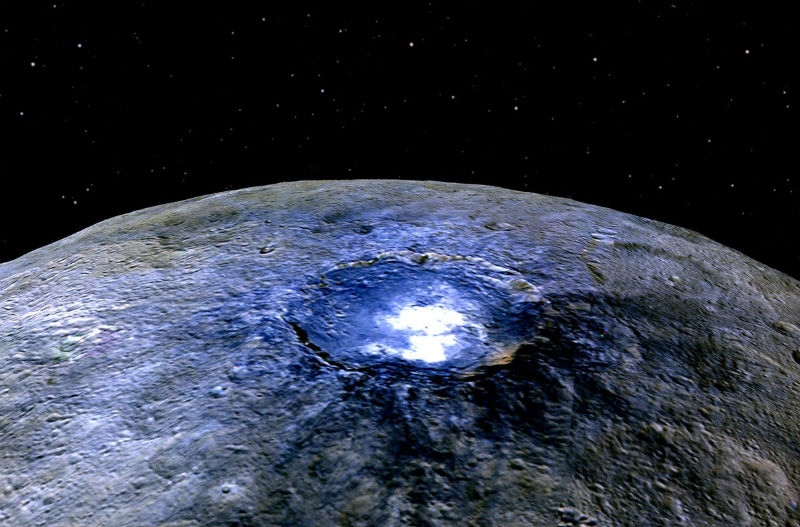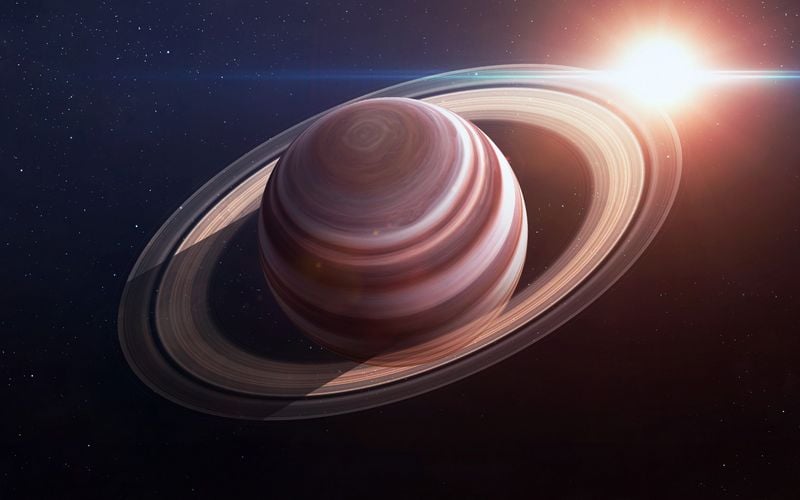The universe is a vast place, so it probably doesn’t come as a surprise that there are a lot of mysteries that cannot (and probably will not ever) be solved. Black holes, dark matter, and issues related to quantum mechanics are understandably puzzling. But on the other hand, you don’t have to look off into a distant galaxy to find phenomena that confound scientists. Here are 10 space mysteries that we are still trying to wrap our heads around.
1. The Glowing Eyes of Ceres
A new amazing mystery was discovered in 2015 when the Dawn spacecraft approached Ceres, the largest object in the Asteroid Belt. When Dawn took photos of what appeared to be a single glowing white spot, but as it approached closer, scientists noticed a whole series of these spots. One theory is that it is caused by a type of salt reflecting light. Other scientists speculate that Ceres was hit by an asteroid that resulted in the shiny material that we now see. Either way, it’s still not entirely known.

2. Monolith on Mars
For quite some time there has been speculation about the existence of various structures on Mars that seem to have been made by intelligent life forms, but most of these – such as the Mars “face” – have been thoroughly debunked. However, the Mars monolith still remains a mystery. Discovered after photo of it was taken by the Mars Reconnaissance Orbiter, it is a rectangular object that measures 16.4 ft (5 meters) wide. Even weirder is a similar monolith on the Martian moon of Phobos, which measures 278 ft (85 meters) across! The fact that Buzz Aldrin himself asked the question, “Who put that there?” is enough to make us wonder.

3. The Origins of the Moon
We all know what the moon is, right? It’s that bright white thing that you see in the sky at night. It rotates around the Earth once a day, creates our ocean tides and all that jazz. But while no object outside of Earth has ever been the subject of so much study than the moon, we have no idea how it formed. One theory is that as the solar system was in its infancy, a Mars-sized planet collided with what would become the Earth, creating a chunk of rock that become the Moon. Another suggestion is that the Moon was merely passing by than got caught by the Earth’s gravitational pull, and Earth adopted it like we would a stray dog. With just as much love, one would hope.

4. Shadow Bans
Total eclipses are something of a mystery, guys. If you just thought, “No! Total eclipses are completely understood” then it means I have the power to read your mind. We obviously know that a total eclipse occurs when the moon moves in front of the sun, obscuring its view. However, what confuses scientists is a phenomenon known as shadow bans. As the moon begins to cover the sun completely, mysterious, shadowy ripples can be observed. They move over everything on earth like waves from the sea. There are a couple of theories about what they might be. Some claim an eclipse creates turbulence in the atmosphere and results in light bending in the air currents. Others speculate that it could be caused by supersonic shockwaves created by the moon’s shadow. In any event, nobody is certain.

5. The Blades of Pluto
When the New Horizon spacecraft flew past Pluto in 2015, it left us with the closest ever view of the planet. One of the most intriguing discoveries of all was what appeared to be a “forest” of tall, jagged ice structures that are the size of skyscrapers. While they resemble the blades of ice that are common in Antarctica, their Earth counterparts are no taller than a human. It’s been suggested that they are formed because methane in Pluto changes back and form between a solid to gas without become a liquid when melting. But this has not yet been confirmed.

6. What is Going on with Saturn’s Rings?
When you think of Saturn, what comes to mind? If you answered, “The failed Sega video game console” I would say, “Hmm. Interesting that you even remember.” As for the rest of you, Saturn is famous for its rings, which are comprised of ice and rock orbiting the planet. Saturn has 62 moons (what a moon hogger!), and they all pull the rings in their direction, much like the moon pulls Earth’s tides. But for some reason that cannot be explained, the rings are also being pulled in the direction of Saturn itself. It is speculated that Saturn has a stable core under the atmosphere that rotates around once every 7 hours. But it still remains unresolved.

7. Why isn’t Venus Like Earth?
Venus is the hottest planet in the solar system thanks to the thick atmosphere that traps in the sun’s heat. This along with the sulfuric acid rain renders iы completely uninhabitable by any type of life form as far as we’ve determined. But given that it is the same size as Earth and revolves around the sun at just the right distance to allow for liquid water on its surface, why did it end up the way it is? One possible explanation is its slow spin. A single day on Venus is equal to 243 Earth days. Since it spins so slowly, it lacks the protective magnetic field that Earth has, which means it is at the mercy of the sun. But why does it have such a slow spin in the first place? This is something that nobody can explain.

8. Does Our Solar System Have a 9th Planet?
We know that there are dwarf planets such as Pluto at the outer edges of our solar system, but some astronomers also argue for the existence of a 9th planet. While this has never been proven, it cannot be ruled out due to all of the contradictory evidence. In fact, evidence in recent years it has started to point to the possibility that our solar system does indeed have an additional planet. This is because certain mathematical models seem to indicate that there is something out that there is exerting influence on nearby objects. If there is indeed a 9th planet, it is thought that it could be around 4 times the size of Earth. But of course, as of yet we have no clue if it even exists.

9. What is ‘Oumuamua?
Astronomers witness all sorts of objects whizzing across space, all of which originated in our solar system. Until ‘Oumuamua was discovered in 2017, that is. This dark red object was traveling at such a high speed that it was agreed that it was of interstellar origin, the first ever sighted passing through our solar system. Nobody has any idea how it got there, but it took millions of years to come. Because it is flying through space so quickly, there is no chance that it will be caught in the solar system’s gravitational pull. This means that as we speak, it is on its way out and head back into deep space.

10. Is there life elsewhere in the Solar System?
Is there life outside of Earth? This is perhaps the greatest mystery of all. Many scientists argue that given how many stars and planets there are in the universe, it would be statistically impossible to conclude that every single one of them is devoid of life aside from our own. In addition, it has been found that bacteria on Earth is extremely resilient, even able to thrive in extreme conditions such as near hydrothermal vents where temperatures can reach 750°F (400°C). Other life forms can live without sunlight. So given all of these conditions, it seems reasonable that life could exist elsewhere, even on the various moons within our solar system with methane oceans and such. But until we find definitive evidence, it will remain a mystery.

